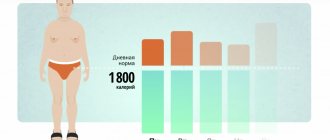To lose weight, overweight people use various methods - mainly diets and fasting systems. However, experts recommend simply adjusting your diet and increasing physical activity. The diet must be designed in such a way that it includes the required amount of fats, proteins, carbohydrates, vitamins, in addition, when calculating it, it is necessary to take into account the optimal amount of calories.
A calorie is a unit of measurement of the energy the body receives when consuming food. If more calories come in from food than are consumed, the excess remains in the body as fat. And an excessive lack of calories leads to exhaustion, which is fraught with all sorts of diseases. To use up accumulated fat reserves without risk to health, you need to create a slight calorie deficit. In this article we will talk about calculating daily calorie intake. All information presented here is intended for educational purposes only and is not a guide to action. Only specialists can accurately calculate calorie intake. But this is not enough for effective weight loss. To get rid of extra pounds forever, you need to use a well-thought-out system, including diet correction, psychological support, and recommendations for physical activity. The Doctor Bormental clinic has its own patented method of losing weight and maintaining results, with the help of which more than half a million people have already lost weight. Read more about the methodology here -.
What is a calorie deficit
A calorie deficit is the negative difference between the calories that come from food and the calories that the body uses during the day.
Visualizing your calorie deficit
Our body's energy comes from calories from food and stores. If there are not enough calories from food to cover the body's daily needs, it will begin to take energy from reserves.
Learn more about the energy balance of the human body, its components and its effect on body weight.
Our body is able to store energy in the form of glycogen, fat tissue, muscle fibers and release it when needed
To start losing weight from fat tissue rather than muscle, you need to create a small calorie deficit, start exercising and increase your protein intake.
Is it possible to lose weight without a calorie deficit? No, this contradicts the energy balance of the human body.
When to expect an effect
Scientific research confirms that weight loss through a calorie deficit will have greater benefits with increased physical activity. Jogging and aerobics have a good effect on fat reserves, causing them to decrease. And by practicing regular cardio-physical training and swimming, a person risks losing not only body fat, but also muscle mass.
In the long term, after 1-1.5 years, a person will lose weight if he sticks to a calorie deficit. But in order to lose weight and maintain it without harming your health, you should create a menu in such a way that there is a balance between healthy foods and those you like.
The goal of any diet, be it strict or based on a calorie deficit, should not be a certain weight and size, but health. If a person sets a goal for himself – losing weight, then he must go towards it gradually, without exceeding the body’s capabilities.
Author: Belyaeva Anna
How to Create a Calorie Deficit for Weight Loss
To create a calorie deficit, you can go in two ways:
- Eat less. If there is little food coming in, our energy reserves (fat tissue, glycogen, muscles) will be used up, and we will begin to lose weight.
- Eat the same, but move more. If, while maintaining nutrition, we increase daily energy expenditure, the body will begin to take energy from reserves, and we will also lose weight.
There are difficulties with the second point, because it is very difficult to correctly estimate and constantly adhere to the required number of calories burned. In addition, the calorie content of your diet should be constant. If you don’t count calories and eat by eye, then the task becomes completely difficult.
To help, a table of energy consumption for different activities:
For a person weighing 70 kg, moderate running at a speed of 8 km/h
for an hour without stopping will burn 485 kcal.
Can you do this type of training every day? Take a look at household activities: cleaning, washing windows, ironing, in total, consume a decent amount of calories and are easier to perform over a long period of time than playing sports. But there is one big BUT.
If you don't count calories, then all your efforts in the gym can be covered by one Snickers bar or portion of dessert:
Snickers Super is two bars of 50.5 g and 540 kcal.
You can count calories not only with the help of kitchen scales and apps, but also with the help of your hands - read about how to learn how to count calories correctly.
Controlling your calorie intake is much easier than controlling your energy expenditure.
The right approach is to combine these two methods, that is, reduce calories consumed and increase physical activity. This way we won’t have to starve (the calorie deficit will be small), and strength training will help keep our muscles toned and keep them on a diet. This is the optimal scheme for men and women.
If you have a lot of excess fat - more than 35% in women and more than 26% in men, then strength training can be traumatic for the musculoskeletal system (how to find out your fat percentage). To begin with, add more simple activity - long walks, spin like a bee around the house, do not use the elevator, cover short distances on foot, etc. By reducing your fat percentage, you can start training at home, on the street or in the gym.
If you have a sedentary job, then you spend less energy. The principles of creating a calorie deficit will remain the same - either eat less or move more, and the best thing is to start counting the calories in food, limit your daily caloric intake and include more activity (walking, gymnastics during breaks at work, training).
We’ll talk about how much you need to limit your caloric intake below.
Contraindications for use
A calorie deficit for weight loss carries a certain risk if foods low in nutrients or, conversely, unhealthy foods are chosen for the diet. The calories that a person consumes are needed in two cases: to live and to be physically active. Eating few calories over time leads to rapid weight loss.
This is normal for those who are overweight, but it also leads to increased cholesterol levels in the gallbladder, which affects the secretion of bile. These processes contribute to the formation of stones over time. People who already have gallstones should not follow a calorie deficit diet.
Restricting calories can cause iron deficiency, lower protein levels, which will affect the immune system and the body's ability to fight colds. This is especially true for athletes who consume 30% fewer calories than they should. People with weakened immune systems should also not resort to diets.
Expectant mothers are not recommended to reduce the amount of nutrients, as this negatively affects the development of the child. In women who frequently resort to diets, they create a calorie deficit, the menstrual cycle is disrupted or stops.
With the cessation of menstruation, the risk of bone loss due to lack of estrogen increases, and this creates the preconditions for the development of osteoporosis and bone fracture. People with low blood pressure should not resort to such diets. Eating according to the principle of a calorie deficit in itself leads to low blood pressure and problems with heart rhythm.
Often, in women who greatly reduce the amount of calories they need, the normal functioning of the thyroid gland is disrupted. During the fasting period, they experience a feeling of cold, depression, and their energy level decreases.
Severe calorie restriction affects fertility. This is especially true for women, since their ability to ovulate depends on their hormone levels. Studies have shown that reducing calories by 22-24% leads to suppression of reproductive function in women.
How to calculate a calorie deficit for weight loss
The calculation algorithm is as follows:
- We determine the maintenance calorie content (at which we do not lose weight or gain weight).
- Depending on your goals, choose the calorie deficit value.
Step 1 - Calculate Maintenance Calories
There are two options to choose from:
- Determine maintenance caloric intake experimentally. The most accurate method.
- Calculate using formulas or online calculators that use these formulas.
First
To get the most accurate result, taking into account the characteristics of your body, lifestyle and activities, you will need a week of time. Choose a time without shocks, moves and upcoming holidays. Weigh yourself in the morning on an empty stomach on the first day and start counting calories. Count absolutely everything that goes into your mouth, except water. Maintain your usual lifestyle and diet throughout the week.
After 7 days, while maintaining your usual diet and activity level, your weight will remain approximately the same as on the first day. Weigh yourself on the eighth day under the same conditions as at the beginning of the week. The numbers may differ (plus or minus half a kilo), this is normal, weight is subject to strong fluctuations even during the day.
Calculate the arithmetic average of daily calories for 7 days and you will get maintenance calories.
Don't try to lose weight or eat "healthy" this week. We don't lose weight, we just determine how many calories we need to maintain our normal weight.
Second
To save a week of time, you can use formulas that determine the body's basic energy metabolism BMR (the minimum amount of energy consumed by the human body to maintain its own life at rest), multiply the result by the activity coefficient and get the maintenance calorie value.
Harris-Benedict formula:
- Men: BMR = 88.362 + (13.397 × weight in kg) + (4.799 × height in cm) - (5.677 × age)
- Women: BMR = 447.593 + (9.247 × weight in kg) + (3.098 × height in cm) - (4.330 × age)
Mifflin-San Jeor formula:
- Men: BMR = (10 × weight in kg) + (6.25 × height in cm) - (5 × age) + 5
- Women: BMR = (10 × weight in kg) + (6.25 × height in cm) - (5 × age) - 161
In order not to count everything manually, use a calculator that will show the result using two formulas:
Calculate the average and multiply the result by the activity coefficient:
- 1.2 – minimal activity.
Sedentary work that does not require significant physical exertion; - 1.375 – weak level of activity.
Training 1-3 times a week. The coefficient is also suitable if you lead an active lifestyle and often walk for a long time; - 1.55 – moderate activity level.
Training 3-4 times a week; - 1.7 – high activity.
Training 5-7 times a week. This also includes work that involves physical labor; - 1.9 – extreme level.
Daily sports with several workouts per day (professional athletes); physically difficult work (miners, builders).
Do not idealize the formulas; they are just a preliminary assessment method that requires adjustment to take into account individual factors.
Step 2 - Choosing a Calorie Deficit
Now that we have the value of maintenance calories, we simply subtract the desired percentage of the deficit depending on the goals and initial data.
Table 1. Options for calculating deficit as a percentage of maintenance calories
| Nature of the deficit | Value from Maintenance Calories | Approximate body weight loss per week | A comment |
| Small | 10-20% | 0,5% | Suitable for people with a small percentage of body fat (for women, the percentage of body fat is less than 25%, for men - less than 16%) for comfortable weight loss. |
| Medium/moderate | 20-30% | 1% | For women with a body fat percentage of 25-34%, for men - 16-25%. |
| Tall/Aggressive | 30-40% or more | More than 1% | For women with a body fat percentage of 35% or more, for men with a body fat percentage of 26% or more, and for quick but short-term results in people with a lower body fat percentage. |
The less a person weighs, the more carefully one needs to create a deficit so that the body does not perceive changes in nutrition as a threat to life and does not slow down metabolism.
For example, let’s calculate the calorie deficit for weight loss for a 26-year-old girl weighing 70 kg, 170 cm tall with a low level of activity.
She figured out her maintenance calories using the two formulas above and took an average of 2080 kcal.
She is in no hurry and wants to lose weight comfortably. Let's choose a deficit value of 15% of maintenance calories.
The formula for calculating the calorie deficit for weight loss is:
2080 - 15% = 2080 - (2080 x 0.15) = 1768 kcal
After a week on a calorie deficit, evaluate the rate of weight loss. If it is 0.5-1 kg, then leave everything as is. If the changes are too small, then reduce calories by another 10%. If weight loss is more than 1 kg per week in people with a small percentage of fat, while strength results deteriorate, then you need to add 10% to the caloric intake of the diet. In all other cases, you can leave the calorie content unchanged.
Table 1 will also help you understand how long it takes to lose weight on a calorie deficit. Go to the article where I tell you in detail how to calculate how long it will take to lose 10 kg.
How to monitor your diet
To switch to proper nutrition and not consume calories in excess of what the body requires, you need to constantly count calories. Some people trying to lose weight use tables, special apps, calorie calculators and count everything they eat during the day. Others schedule the menu a week or two in advance. This is a more convenient option that allows you not to think about kilocalories every hour. You can entrust the preparation of a weekly menu to a specialist, and then just stick to it and not be tricky with constant calculations. But for those who spend a lot of time outside the home, often eat in restaurants and do not have the opportunity to eat only personally prepared food, it is easier to keep calculations throughout the day. The main thing is not to lose vigilance and adhere to the established norm.
Switching to a lower calorie diet is usually accompanied by a persistent feeling of hunger. In this state, a person constantly thinks about food, which further stimulates the appetite. Nutritionists advise sticking to fractional meals, which allows you to reduce your daily caloric intake with minimal discomfort. The simplest option for fractional nutrition is to distribute all daily calories into 5 meals. The portions will be smaller, but the time interval between meals will also be reduced.
For breakfast, you should choose foods with “slow” carbohydrates. They will be digested longer, maintaining a feeling of fullness. For dinner, it is recommended to eat quickly digestible food.
It is quite difficult to monitor your diet all the time. This can get boring quickly. But to lose weight and maintain an ideal figure, it is not more important to control your diet, but to develop the right eating habits. You need to gradually learn to eat less, according to a schedule, using healthy foods. In order to stimulate metabolism, you should start the day with a glass of lemon water and prepare oatmeal for breakfast. Make it a habit to drink plenty of fluids frequently and exercise regularly.
Why am I not losing weight on a calorie deficit?
If you have created a calorie deficit, then know that weight loss is not linear.
Graph of the dynamics of average weight loss - after the first results, the weight increased. Taken from https://znatok-ne.livejournal.com/98839.html
This happens due to the adaptation of our body. In response to diet and training activity, the body tends to compensate for changes:
- Resting energy expenditure (BMR) is reduced because body weight has decreased and fewer calories are now required to provide energy;
- The thermic effect of food (TEF) is reduced. TEF is the number of calories the body needs to burn to digest and absorb a volume of food. Since someone who is losing weight eats less, these costs are reduced;
- Costs for non-training activity (NEAT) are reduced - due to a decrease in calorie intake, a person gets tired of training faster and moves less, has less motivation to do something, wants to sit down or lie down;
- The cost of training activity (EAT) is reduced - the lighter a person is, the fewer calories the body spends on physical activity.
In women, the adaptation of the body against the background of reduced caloric intake is slightly more pronounced than in men.
Therefore, at a time when the weight does not go away or even increases, but not more than once every 2-4 weeks, it is necessary to correct the deficit.
At the beginning of the diet, weight may not decrease, including due to water retention in the body. Read how the body's water balance affects body weight.
See your results and then the table below.
Table 2. Deficit adjustment parameters
| Weight loss | Changes |
| Less than 0.5 kg per week | Cut calories by another 10% |
| 0.5 – 1 kg per week | Without changes |
| Lose more than 1 kg per week for those with a body fat percentage of ≤15% men/≤24% women and training performance is not impaired | Without changes |
| Losing more than 1 kg per week for those with a body fat percentage of ≤15% men/≤24% women and training performance deteriorates | Increase calories by 10% |
| Losing more than 1 kg per week for those with body fat percentage ≥16% men/≥25% women | Without changes |
The adjustment itself can be done by reducing the caloric intake of the diet or by increasing physical activity.
Ideally, combine two methods: cover one half by reducing the caloric content of the diet, the second half by adding, for example, 10-15 minutes of cardio training (for a person weighing 70 kg, 10 minutes of moderate running at a speed of 8 km/h will burn 81 kcal). This will make it more comfortable to maintain a diet and it will work when there is nowhere to cut your diet, especially if it was modest from the very beginning.
Data on various activities with which you can create part of the deficit are given in the tables below:
Calorie norm - calculation using gadgets
Today, many people use modern gadgets for calculations. Fitness bracelets have the corresponding functions; you can download and install the counter application for free on Android. For example, the Kaloriyka smartphone program is now very popular. However, the results of such calculations are not the most accurate. It is better to go to an appointment with a nutritionist who will take into account all your individual lifestyle characteristics, health status, genetic predisposition to various diseases and much more.
Making allowances for physical activity
The process of losing weight involves not only changing your diet, but also increasing your physical activity. You need to calculate your calorie intake taking into account which training option you have chosen. During a normal walk, a light gentle warm-up, and training, for example, on a stepper, energy consumption is different.
It is very important to take into account how much energy is burned during a particular type of exercise. During intense physical activity, energy consumption is higher, but in order to make the body strong and beautiful, static or power loads are also needed. When doing them, calories are also consumed, although not as quickly as when working on cardio equipment. Thus, the now popular plank exercise burns from 5 to 12 calories per minute.
Heavy training, which involves a high loss of energy, allows you to quickly lose weight and gain muscle mass. But an intense training regimen requires special nutrition. Some people use factory-made or homemade protein shakes, which provide maximum energy, reduce appetite, and speed up metabolism.
Reducing calorie intake
An overweight person probably exceeds his daily calorie intake. After calculating the norm, you need to calculate how many calories are currently consumed. It is recommended to write down everything you eat and drink in a diary over a certain period. Then, based on the calorie tables, the average calorie consumption per day is calculated. The difference between real data and the norm can be impressive. But you shouldn’t drastically reduce your diet. We need to do this gradually.
Experts recommend reducing the nutritional value of the daily diet by 100-300 kcal per week. In pursuit of a quick effect, many people who are losing weight reduce the nutritional value of their diet by 600 or even 700 calories at once, but such sudden changes can lead not to weight loss, but to a slowdown in metabolism. In fact, the process of reducing calories requires an individual approach. It is better to go this route under the supervision of a nutritionist who is ready to adjust your diet at different stages of weight loss.
It is important not just to reduce the calorie intake, but to completely switch to healthy foods and dishes, giving up what is harmful to health and brings extra pounds. You also need to gradually give up your favorite junk food. The first step is to remove sausages, fatty fried meats, confectionery, and sweet carbonated drinks from your diet. It is necessary to think about replacing the usual dishes. Fried pork should be replaced with boiled or baked chicken, turkey, and veal. Regular bread should be replaced with yeast-free or bran bread. Rice flour is used instead of wheat flour. Instead of carbonated drinks, drink black or green tea with lemon, cinnamon, and ginger.
When reducing calories, you need to pay special attention to the content of proteins, fats, and carbohydrates in the new diet. The content of sugar in 100 grams of product is indicated in the calorie tables. We must not forget about the existence of healthy foods with high calorie content. It is impossible to abandon them completely. For example, hard cheese or fetax is a high-calorie product, but even a small piece of this product contains a lot of proteins, vitamins, and minerals. Cheese of various types is introduced in small portions into a healthy diet.
Studying the reviews of those losing weight, you can come to the conclusion that it is much easier to lose weight with a varied menu. You can prepare healthy food using special dietary recipes.
How to maintain a calorie deficit
So, you have determined your maintenance caloric intake and the deficit you need. To maintain a calorie deficit and lose weight:
- Don't forget to count calories. This is necessary to do to know exactly how much you eat.
- Add physical activity if there are no contraindications for it. Working out will increase your calorie burn and maintain muscle while you diet.
- Weigh yourself every day at the same time, under the same conditions. It's better in the morning on an empty stomach. This way you will see the dynamics of weight change.
- As you lose weight, adjust the deficit according to Table 2.
- Take care of a proper diet - go to the article where I tell you how to eat on a diet in a way that is convenient for you.
Essence and basic principles
Calorie deficit for weight loss is a term that indicates how much the caloric content of foods should be less than the energy expended by a person.
Human energy consumption is related to the following indicators:
- age;
- physical activity;
- constitutional body type.
The average person receives 2000-2500 calories per day. Scientists have calculated that the “gold standard”, which satisfies all the nutritional needs of the body, is only 1,300 calories. With this amount, there are no excess reserves that are deposited in the tissue. Thus, a deficit of food intake should be created.









